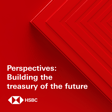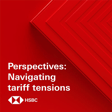Become a Creator today!Start creating today - Share your story with the world!
Start for free
00:00:00
00:00:01

The ESG Brief - Data science and the risk of diversity washing
In this edition, Yaryna Kobel, Mark McDonald and Camila Sarmiento focus on how we've applied data science to determine whether corporate diversity discussions are being matched with action. Disclaimer. To stay connected and to access free to view reports and videos from HSBC Global Research click here
Hosted on Acast. See acast.com/privacy for more information.
Transcript
Introduction to HSBC Global Viewpoint Podcast
00:00:01
Speaker
Welcome to HSBC Global Viewpoint, the podcast series that brings together business leaders and industry experts to explore the latest global insights, trends, and opportunities.
00:00:13
Speaker
Make sure you're subscribed to stay up to date with new episodes.
00:00:16
Speaker
Thanks for listening.
00:00:17
Speaker
And now onto today's show.
Overview of ESG Brief and Corporate Diversity
00:00:26
Speaker
Hello everybody and welcome to the ESG Brief, our regular review of the environmental, social, and governance landscape by HSBC Global Research.
00:00:35
Speaker
I'm your host, Jack Reed.
00:00:37
Speaker
In this edition, we're looking at the ESG team's recent report on corporate diversity and data science.
NLP in Analyzing Conference Calls for Diversity Insights
00:00:44
Speaker
Using the powers of natural language processing, what can we learn from the transcripts of corporate conference calls with investors about employee gender diversity?
00:00:54
Speaker
Are the words from executives about diversity translating into actions that actually diversify the workplace?
00:01:01
Speaker
To answer these questions, I'm joined here in London by Mark McDonald, the head of data science and analytics, Marina Cobal, our corporate governance analyst, and in New York by our ESG analyst, Camilla Sarmiento.
00:01:15
Speaker
A governance note of our own first, this report was recorded for publication on the 20th of September.
00:01:21
Speaker
All the disclosures and disclaimers associated with it must be viewed on the link attached to your media player.
Importance of Corporate Diversity for Investors
00:01:28
Speaker
Irina, let's start with you.
00:01:29
Speaker
What did you set out to investigate in this report and why?
00:01:34
Speaker
Yes, we set out to investigate corporate diversity.
00:01:39
Speaker
According to our most recent EHD sentiment survey, diversity remains a top social issue investors are planning to spend most of their time in the next 12 months.
00:01:53
Speaker
Diversity is complex and we have investigated diversity in many different ways in the past, but this time, together with our data science team, we looked at the frequency of diversity mentions on earning calls in different sectors and regions.
00:02:11
Speaker
As there is a limited amount of time for discussion on earning calls, we believe that frequency of diversity mentions is a good proxy for the degree to which management and investors are prioritizing diversity.
Gender Diversity as Management Priority Proxy
00:02:25
Speaker
And then we compared this frequency with workforce and board gender diversity progress to better understand where the focus should be.
00:02:34
Speaker
So effectively, you're looking at whether the words of company executives are being matched by deeds.
00:02:39
Speaker
Yes, yes, indeed.
00:02:40
Speaker
We looked at the progress between 2018 and 2021.
00:02:47
Speaker
That's when the frequency of diversity mentions actually changed a lot.
00:02:53
Speaker
And we specifically selected gender as it has been probably the most extensively studied and easily measurable characteristics.
00:03:03
Speaker
So we think that it can provide a useful basis for our diversity analysis.
00:03:08
Speaker
Now before we look at the broad findings of the report, I want to turn to Mark McDonald.
00:03:12
Speaker
Mark is the head of our data science team.
00:03:15
Speaker
Mark, you have used natural language processing for a number of different teams in global research.
00:03:21
Speaker
Take us through what the process has been in this case.
00:03:25
Speaker
So again, in this situation, we're returning to what companies are saying on their earnings calls.
00:03:32
Speaker
And we keep returning to this because it's fantastically rich data sets.
00:03:36
Speaker
Now, of course, analysts and investors will often dial into a conference call and listen to what's being said.
00:03:43
Speaker
And the reason that they do this is that often on an earnings call, information is disclosed, which may not be officially disclosed anywhere else.
00:03:51
Speaker
Now, we're not listening to the calls.
00:03:54
Speaker
We're using earnings call transcripts.
00:03:56
Speaker
So after the call, what's said on the call gets transcribed.
00:04:01
Speaker
And then we apply our natural language processing techniques to us.
00:04:05
Speaker
And the reason that we do this is you get a vast amount of information.
00:04:11
Speaker
In each reporting season, you get thousands of new transcripts.
00:04:15
Speaker
And this is millions of sentences.
00:04:16
Speaker
That's obviously far too much material for any human to even really scratch the surface.
00:04:23
Speaker
But of course, that's perfect for a machine.
00:04:26
Speaker
Our natural language processing algorithms can just as easily be applied to thousands of earnings calls as they can to one.
Trends and Challenges in Diversity Mentions
00:04:34
Speaker
So it's a very powerful analytical technique that can bring out sort of macro themes from very micro data sets.
00:04:43
Speaker
And presumably you can strip out a lot of the noise, for example, words like diverse or diversification, which could be applied to a lot of things that aren't necessarily about gender diversity.
00:04:53
Speaker
Yes, that's exactly right.
00:04:56
Speaker
The key aspect of any of these natural language processing analyses.
00:05:01
Speaker
The first step is to hone in accurately and precisely on the subset of the sentences that are about the theme at hand.
00:05:10
Speaker
And that's often the most time-consuming part of the analysis is improving that until that works.
00:05:19
Speaker
Turning to you, Camilla, what does the data show us?
00:05:22
Speaker
So when looking at our data, we found that diversity discussions on earning calls have increased exponentially over the past decade.
00:05:31
Speaker
So looking at 2021, they are about 15 times more likely to occur than a decade ago.
00:05:37
Speaker
And we found similar trends relating to just specifically speaking about board diversity as well.
00:05:44
Speaker
Now, looking at 2022, we don't have obviously a complete year of data yet, but it is coming in slightly below 2021 data.
00:05:54
Speaker
Now, we think this could be attributed to various global events that may have shifted company focuses towards managing these emerging risks.
00:06:04
Speaker
But we still think that diversity and inclusion is very much remains a top priority for corporates and investor engagement, as Yurina had said.
Concerns of Diversity Washing
00:06:15
Speaker
From this vast amount of data gleaned from transcripts and the specific mentions of diversity in conference calls, what's the takeaway, Irina?
00:06:25
Speaker
So our main takeaway for different sectors and regions is that investors should consider the risk of diversity washing.
00:06:34
Speaker
And I'm saying this because when we match the frequency, the high frequencies of diversity mentions, we realize that it's not matched by gender diversity progress.
00:06:46
Speaker
So most of the diversity discussions, they are actually driven by management on the calls.
00:06:54
Speaker
And we see a lot of general comments.
00:06:57
Speaker
For example, they're talking about maintaining a strong focus on diversity, remaining actively engaged to foster gender diversity or being satisfied with a diverse qualified boards or peers.
00:07:09
Speaker
progress made.
00:07:10
Speaker
So as you can see, those are really all general comments and they often give no detail as what it actually means.
00:07:20
Speaker
So we think that corporates, they actually feel stakeholder pressure to make a statement on diversity as if to check a box without strategically acting on improving diversity without their businesses.
00:07:34
Speaker
And just to add there on some examples from our analysis, we found that when looking at sectors specifically, the utility sector had the highest frequency of discussions of diversity on their earnings calls.
00:07:51
Speaker
However, they had very little progress on their gender diversity across their board and senior and organizational management levels.
00:08:00
Speaker
So, you know, here we're seeing, you know, higher risks of diversity washing.
00:08:05
Speaker
Now, looking at more of the regional areas, we also found risks of diversity washing specifically within the LATAM area.
00:08:15
Speaker
This is because there has been very little progress and also engagement by governments on diversity within Latin America.
00:08:23
Speaker
However, they also had the highest frequency of diversity discussions on earnings calls as well.
Ensuring Genuine Diversity Efforts
00:08:29
Speaker
One of the things that you have included in the report is a recommended set of questions that investors can ask corporates to prize out more information about their diversity agenda.
00:08:40
Speaker
What is the goal here, Irina?
00:08:42
Speaker
Yes, we propose eight questions for investors to help them assess how corporates incorporate diversity considerations into their organizational practices.
00:08:53
Speaker
So these questions focus on a number of issues.
00:08:56
Speaker
So that's, for example, succession planning and automation challenge or some sector-specific considerations.
00:09:05
Speaker
We think these are really useful questions because we believe that there's opportunity for investors and earning calls to
00:09:12
Speaker
hold corporates to greater transparency on the progress made against the diversity strategies.
00:09:18
Speaker
And these questions, we believe, will help them to focus on specific diversity actions and progress, helping to address diversity washing and drive better progress on diversity globally.
Sector-Specific Gender Diversity Issues
00:09:35
Speaker
And Camilla, aside from the issue of diversity washing, what else stands out in this research at a sector level?
00:09:42
Speaker
I think one of the main differences in the sectors that we found was kind of these sector-specific differences in historical gender makeup.
00:09:50
Speaker
So we have a lot of sectors that have been the majority female or majority male.
00:09:55
Speaker
And what this means for diversity is a question that we asked ourselves.
00:10:00
Speaker
A prime example here is the basic materials sector, which has been very male-dominated.
00:10:04
Speaker
This has been due to many of the characteristics, like physical strength, that are needed in the industry.
00:10:11
Speaker
So there are very different views on what the gender balance should be in different sectors.
00:10:16
Speaker
You know, we believe there's just a continuous focus on diversity will promote gender diversity.
00:10:21
Speaker
Again, to the basic material sector, while they still are majority male, they have had some of the largest progress percentages across the sectors.
00:10:32
Speaker
And there also is the opportunity here for different technologies and automation, which could allow these
00:10:39
Speaker
these sectors become more gender balanced as different characteristics like physical strength with new technologies might not be as important.
Regulatory Influences on Diversity Discussions
00:10:50
Speaker
And how does the data that you're looking at differ on the regional level?
00:10:55
Speaker
So I think the largest consideration regionally is the regulatory initiatives that are being put in place to promote diversity by different regulatory bodies around the world.
00:11:05
Speaker
So we have seen this through disclosure requirements and through board and senior management level quotas and targets, and more specifically relating to the UK and the US areas that have been promoting diversity.
00:11:20
Speaker
And when we look at our diversity discussions on earning calls, we found that those regions which had a high frequency of diversity discussions also had regulatory initiatives in place.
00:11:32
Speaker
And so we found that these kind of regulatory initiatives that are going on have been key drivers, we think, of these discussions that are happening on earnings calls.
00:11:42
Speaker
So lots to digest in this report and some helpful guidance for investors who may want to push corporates on the precise actions underway on diversity.
Data Science in ESG Research
00:11:51
Speaker
A final question to you, Mark.
00:11:53
Speaker
The use of data science and natural language processing in HSBC Research's products and services has clearly grown over the past couple of years.
00:12:02
Speaker
What are you learning in the process here?
00:12:05
Speaker
Well, in many ways, the way that we've been doing this is actually the ESG team have been helping out the data science team.
00:12:12
Speaker
So often with these natural language processing analyses, one of the hard things is to identify accurately and precisely
00:12:22
Speaker
the sentences that are about that topic.
00:12:24
Speaker
And with many ESG themes, the language that would be used to discuss that theme is often used metaphorically elsewhere.
00:12:32
Speaker
So as an example, if you simply search for the word environment on an earnings call, the vast majority of those are false positives, where it's people talking about the funding environment or the competitive environment.
00:12:44
Speaker
And similarly, mentions of sustainable are typically talking about dividend sustainability rather than ESG sustainability.
00:12:53
Speaker
And so the only way to accurately hone in on many of these ESG themes is to train a machine learning model how to identify them.
00:13:04
Speaker
And what this means is that you need trained experts to go through thousands of examples of sentences and to mark them down that this one is relevant and this one is not.
00:13:13
Speaker
And
00:13:14
Speaker
with enough examples, these models can hone in and accurately identify, yes, this sentence is about that theme and no, this sentence is not.
00:13:23
Speaker
And so we've been working closely with the ESG team.
00:13:26
Speaker
They are the trained experts that I referred to that have done this analysis.
00:13:30
Speaker
So we now have these models that can hone in at a very granular level and say, yes, this sentence is about this theme and then we can start applying that analysis
00:13:39
Speaker
in a variety of ways.
00:13:41
Speaker
So really, I'm fantastically grateful to my colleagues in the ESG team for that work.
00:13:47
Speaker
Mark, Camilla and Yurina, thank
Conclusion and Podcast Access Information
00:13:50
Speaker
you very much.
00:13:50
Speaker
Super interesting report.
00:13:52
Speaker
Thanks, Jack.
00:13:53
Speaker
Thanks for having us on the podcast.
00:13:55
Speaker
For Global Research clients, the full report is available on the research website at research.hsbc.com.
00:14:01
Speaker
The report's also showcased on the Global Research app.
00:14:05
Speaker
Thank you for joining us.
00:14:07
Speaker
If you have any questions, please do email us at askresearch at hsbc.com.
00:14:12
Speaker
And don't forget, if you're listening to this podcast at your desktop, you can also find the ESG Brief on Spotify and Apple, along with our weekly macro viewpoint and our newest podcast, Under the Banyan Tree.
00:14:26
Speaker
Just search for the HSBC Global Viewpoint channel and you'll find us there.
00:14:30
Speaker
Thanks very much for listening.
00:14:32
Speaker
We'll be back soon.

















